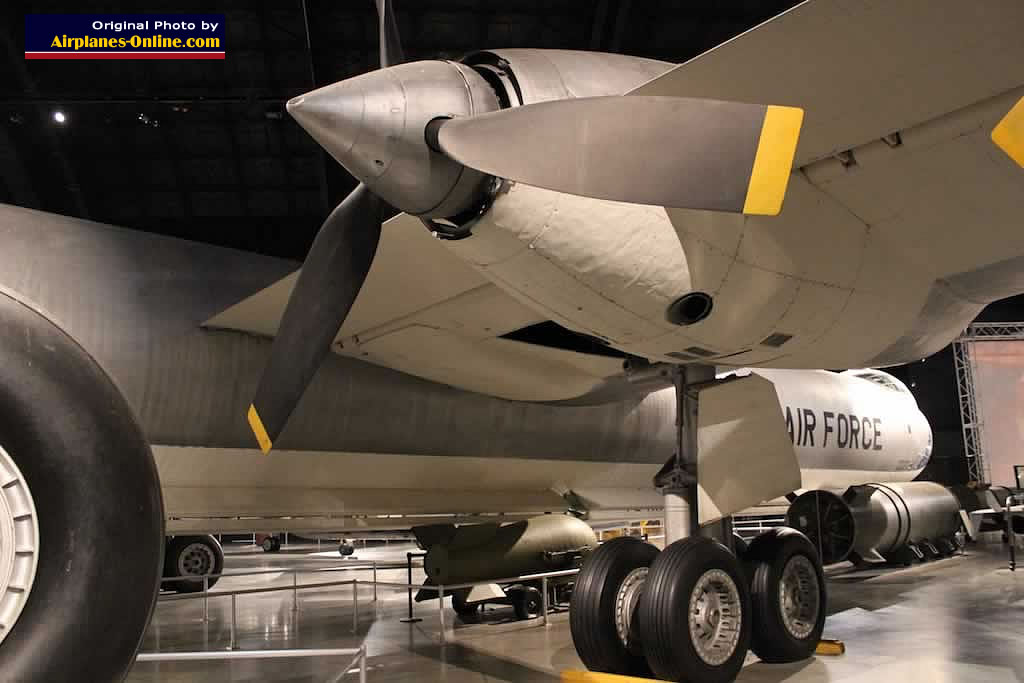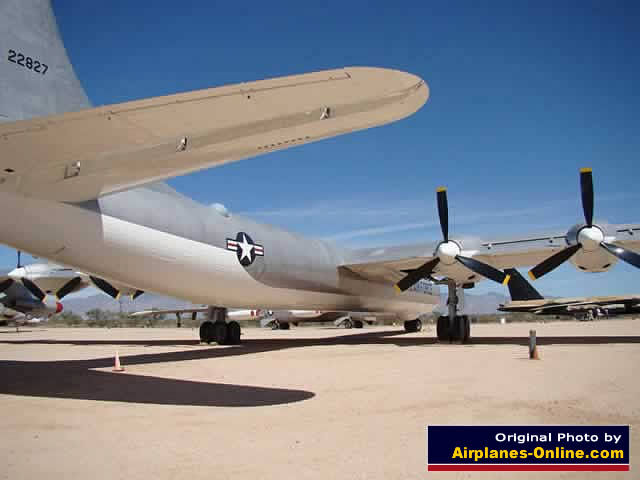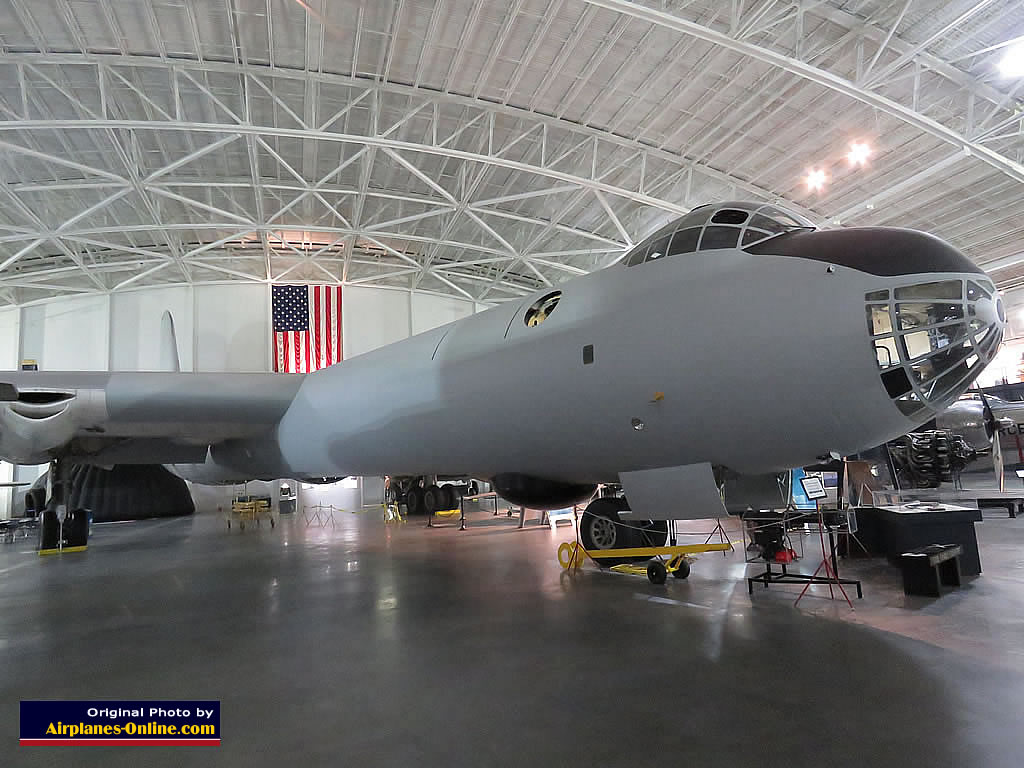Convair B-36 Peacemaker Design, Specifications, Deployment and Photographs
U.S. Requirements for an Intercontinental Bomber
More About the B-36: Design, Production, Deployment & Scrapping B-36 - National Museum of the U.S. Force B-36 - Pima Air & Space Museum B-36 - Strategic Air Command & Aerospace Museum |
The Convair B-36 Peacemaker was one of the largest aircraft ever built, and was instrumental in maintaining peace during the Cold War with Russia during the 1950s. It was originally conceived in 1941 as an intercontinental bomber, and came into production in the late 1940s.
The U.S. Army Air Corps' specifications for this very heavy, long-range nuclear bomber required it to have a top speed of 450 mph, a service ceiling of 45,000 feet, carry a 10,000 pound bomb load, and fly non-stop for 12,000 miles.
This would enable the super bomber to strike targets in Europe from air bases in the United States, and return to their home base without refueling.
Bids were issued to the Boeing Aircraft Company, and also to Consolidated Aircraft, the ultimate winner of the B-36 contract.
B-36 Peacemakers Flying Today
Many people ask ... are there still any B-36 bombers flying today? Sadly, today, only four Peacemakers survive, and they are all on static display in museums. There are no B-36s in airworthy condition.
![]() About the restoration of a B-36 to airworthy status
About the restoration of a B-36 to airworthy status
B-36 Flight Testing and Acceptance
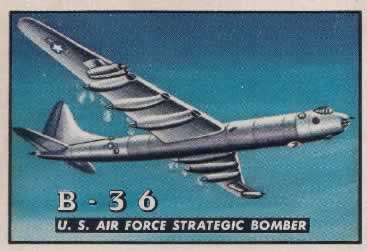 B-36 U.S. Air Force Strategic Bomber - TOPPS Wings Friend or Foe Card #24 |
The XB-36 (S/N 42-13570) made its maiden flight on August 8, 1946. The second prototype was designated the YB-36 (S/N 42-13571), and flew for the first time on December 4, 1947.
The first B-36A (S/N 44-92005) was accepted in May of 1948.
Much of the B-36's external skin was made of magnesium, which had a dull color, in contrast to the shiny aluminum used to cover the fore and aft pressurized compartments.
These giant bombers were built by the Consolidated Vultee Aircraft Corporation (later known as Convair) at its assembly plant across the runway from Carswell Air Force Base in Fort Worth, Texas.
Convair XB-36 Peacemaker S/N 42-13570 |
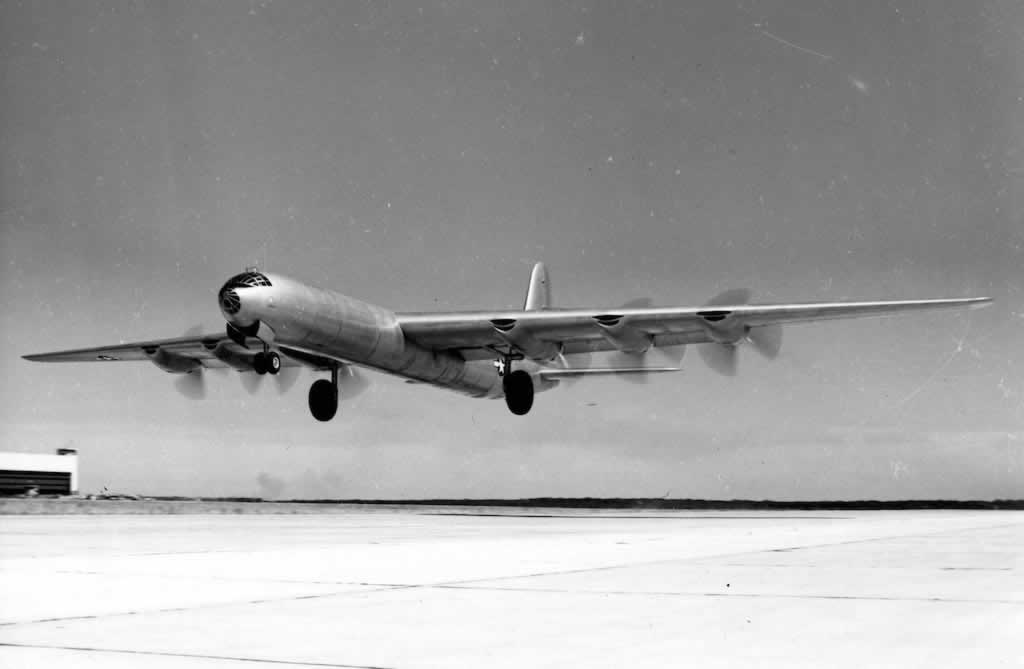 |
Convair B-36 Peacemaker Assembly Line in Fort Worth |
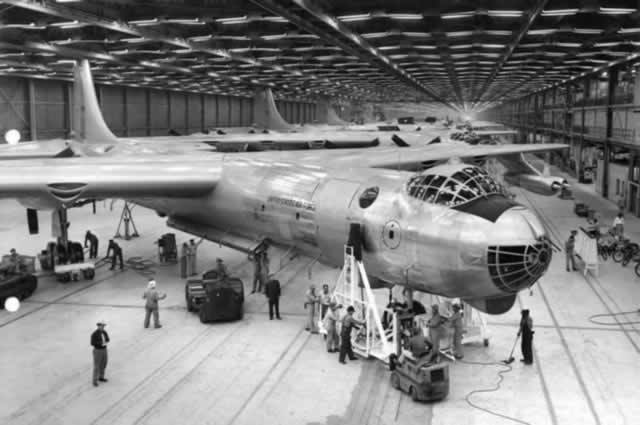 |
B-36 Design Evolution and Model Production
During production of the Peacemaker, Convair and the Air Force evolved the plane to the B-36B, B-36D, B-36F, B-36J and B-36H models.
A major change to the original, basic B-36 design was the addition of jet engines. Beginning with the B-36D, the Peacemaker added four General Electric J47-GE-19 jet engines, mounted in pods like those used in the Boeing B-47.
Ultimately, the Air Force had all earlier B-36 units reconfigured with the jet engines. With 6 propellers mounted on the back of the wings and an additional 4 jet engines mounted on the wingtips, the term "six turning, four burning" became popular.
The B-36J was the last production series, most of which were "Featherweight III" models. Older models were retrofitted as "Featherweights" to reduce weight and improve speed. A large number of reconnaissance versions were also built, including RB-36H models.
B-36 PeacemakerU.S. Air Force B-36J 52-2220 at the Museum of the United States Air Force, Wright-Patterson AFB, Dayton, Ohio
|
|
||||||||||||||||||||||||||||||||||
B-36J 52-2827 at the Pima Air and Space Museum in Tucson, Arizona (Staff Photo) |
One of the more famous of the B-36 line was B-36H-35-CF Serial Number 51-5734, used in the memorable startup and takeoff sequences in the Strategic Air Command movie. It arrived on August 27, 1957 at Davis-Monthan AFB for reclamation; it was scrapped in November of 1957.
Convair B-36A Peacemaker, S/N 44-92006, Buzz Number BM-006 |
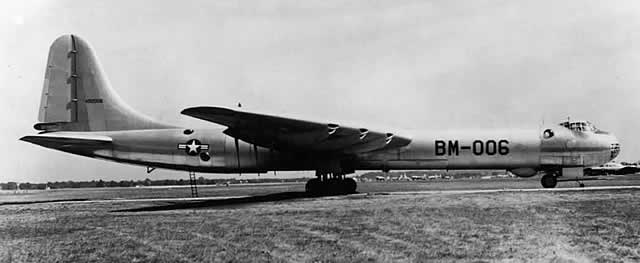 |
| B-36B Peacemaker, S/N 44-92033, Buzz Number BM-033, in flight |
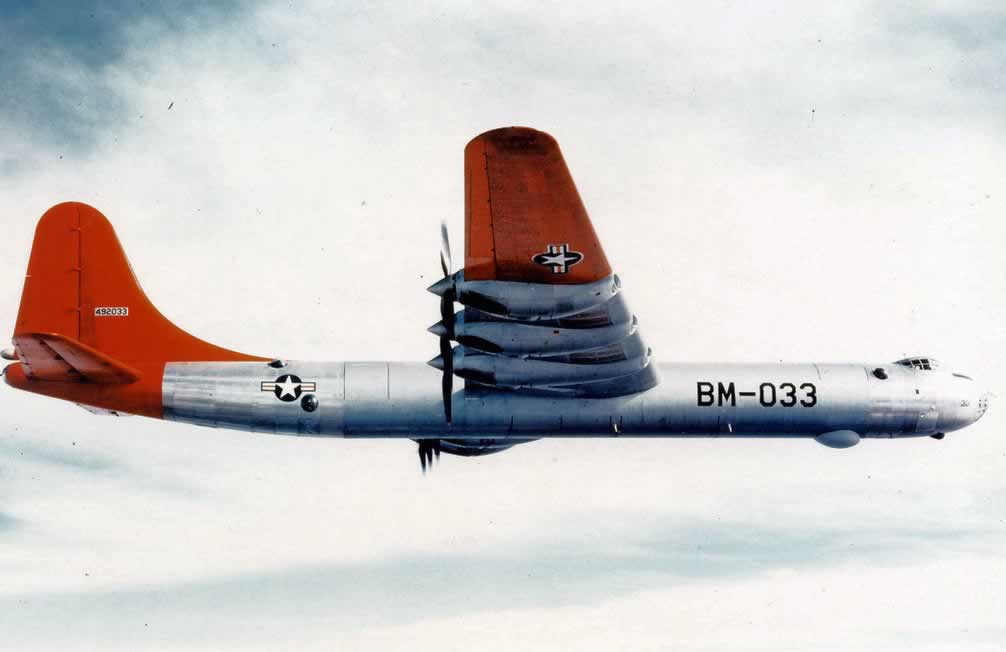 |
Convair RB-36D Peacemaker |
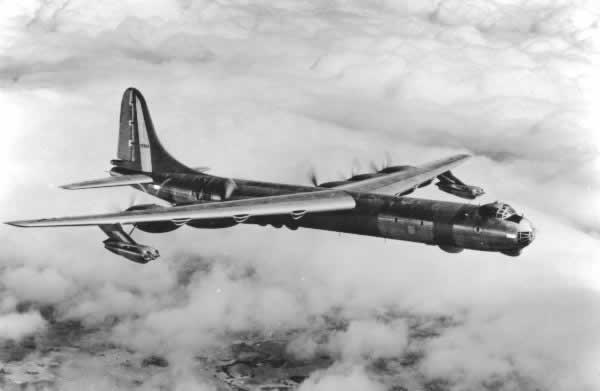 |
USAF Convair B-36F Peacemakers in flight from Walker AFB, 6th Bomb Wing |
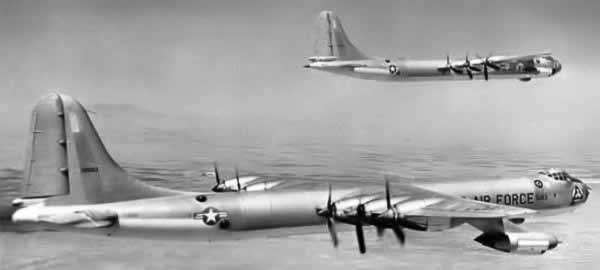 |
USAF Convair B-36J Peacemaker in flight |
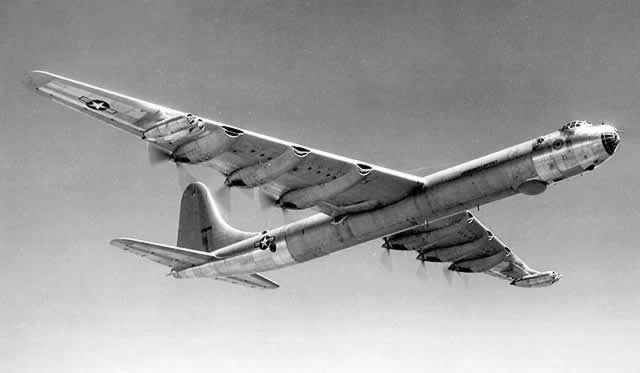 |
| Convair B-36J-75-CF Peacemaker, S/N 52-2827, the last production B-36J, now on display at the Pima Air & Space Museum in Tucson |
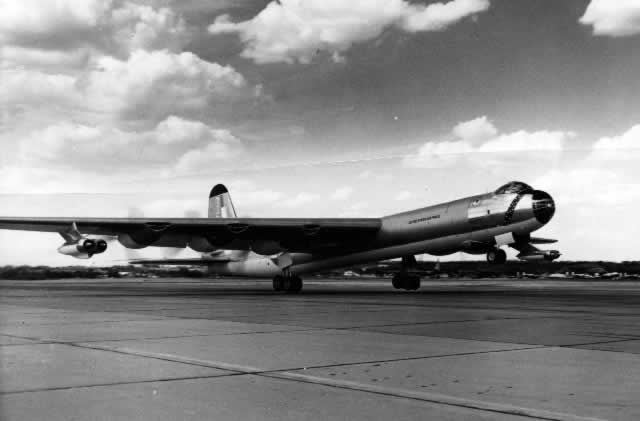 |
Specifications of the USAF B-36 Peacemaker Bomber
The size, dimensions and power of the B-36 are staggering. Some notable facts:
- Design competition begun in April 1941 for a long-range aircraft
- First flight of the airplane: August 8, 1946
- First deliveries to the U.S. Air Force: November, 1948
- Retired: February 12, 1959
- Number built: 382, plus one XC-99 transport and two YB-60 jet bomber variants
- Builder: Consolidated Vultee Aircraft Corporation, later to become Convair
- Engines: six Pratt & Whitney piston, four J47 jets
- Wingspan: 230'
- Length: 162'
- Height: 46' 9"
- Weight: 410,000 pounds loaded
- Maximum bomb load: 86,000 pounds
- Service ceiling: 45,000 feet
- Maximum speed: 435 miles per hour
- Crew: 15
- The B-36 was the largest mass-produced piston engined aircraft ever made
B-36 Deployment in the United States Air Force
A number of U.S. Air Force wings and air bases would operate the B-36, including the following:
Air Force Base |
USAF Wing |
Carswell AFB, TX |
7th Bomb Wing (Heavy) |
| Carswell AFB, TX | 11th Bomb Wing (Heavy) |
| Biggs AFB, TX | 95th Bomb Wing (Heavy) |
| Travis AFB, CA | 5th Bomb Wing (Heavy) |
| Travis AFB, CA | 9th Bomb Wing (Heavy) |
| Loring AFB, ME | 42nd Bomb Wing (Heavy) |
| Walker AFB, NM | 6th Bomb Wing (Heavy) |
| Ellsworth AFB, SD | 28th Bomb Wing (Heavy) |
| Fairchild AFB, WA | 92nd Bomb Wing (Heavy) |
| Fairchild AFB, WA | 99th Bomb Wing (Heavy) |
| Ramey AFB, PR | 72ndBomb Wing (Heavy) |
B-36 and the FICON Project
The B-36 was used for testing in the Fighter Conveyer (FICON) project with attached "parasite" fighters including the XF-35 Goblin and modified F-84 and F-84F jets.
McDonnell XF-85 Goblin, 6523, designed to be deployed from a B-36 as a protective fighter, on display at the Museum of the United States Air Force in Dayton, Ohio(Staff Photo) |
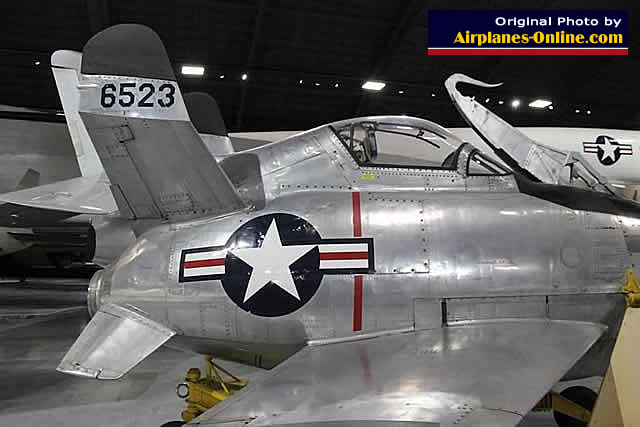 |
Front view of the XF-85 "Goblin", S/N 46-0524, the experimental B-36 "Parasite Fighter-Escort", on display at the Strategic Air & Space Museum in Ashland, Nebraska (Staff Photo) |
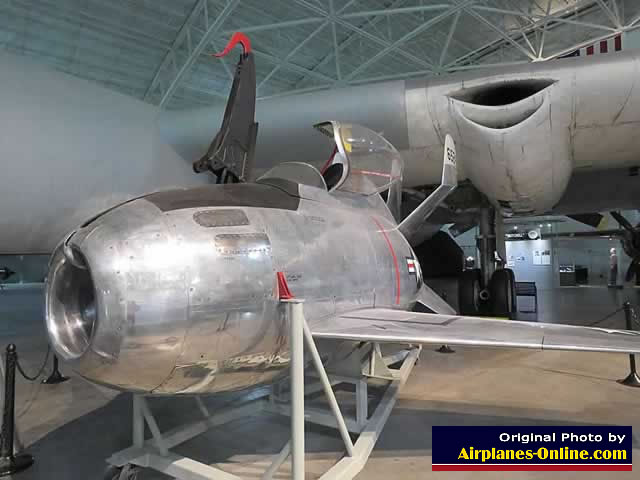 |
B-36F launching a F-84F during FICON testing |
Convair's Project to Build an All-Jet B-36: The YB-60
As jet aircraft began to emerge in the late 1940s and early 1950s, Convair started design on a swept-winged version of the B-36 with all-jet propulsion, known as the Convair YB-60. It also designed and built a prototype large-scale transport plane, the Convair XC-99.
In March 1951, the US Air Force authorized Convair to convert two B-36Fs to B-36Gs. Since the jet aircraft was so different from production B-36 models, the designation was later changed to YB-60.
The eight-engine YB-60 shared 72% of its parts with the B-36. The fuselages of the two aircraft were nearly identical, although the YB-60 had a longer, pointed nose with a needle-like instrument probe, instead of the B-36's rounded nose.
Convair YB-60 on apron |
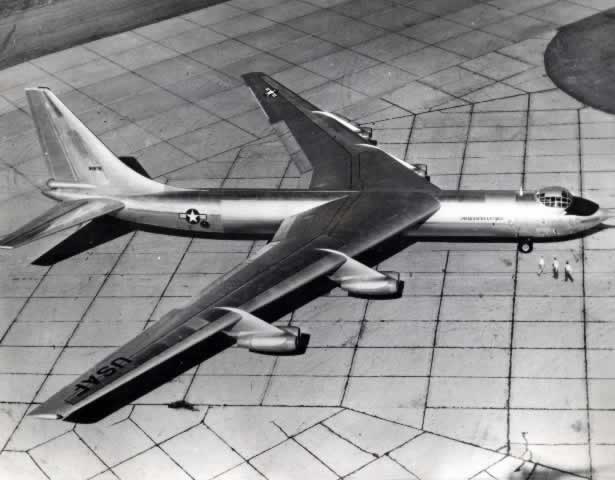 |
The Cargo Version of the B-36: The XC-99
The other variant of the B-36 was the giant cargo plane, the XC-99 (S/N 43-52436) , the largest piston-engined aircraft in the world. It was built at the Consolidated plant in San Diego, had its maiden flight on November 23, 1947, and was delivered to the Air Force in May of 1949.
The XC-99 was used for many years in active service. The XC-99 logged more than 7,400 hours of flying time and moved more than 60 million pounds of cargo. The plane made its final voyage on March 19, 1957.
The US Air Force determined that it had no need for such a large, long-range transport plane at that time, and no more were ordered. The sole XC-99 served until 1957, including extensive usage during the Korean War.
B-36 Peacemaker (left) and Convair XC-99 (right) in flight formation |
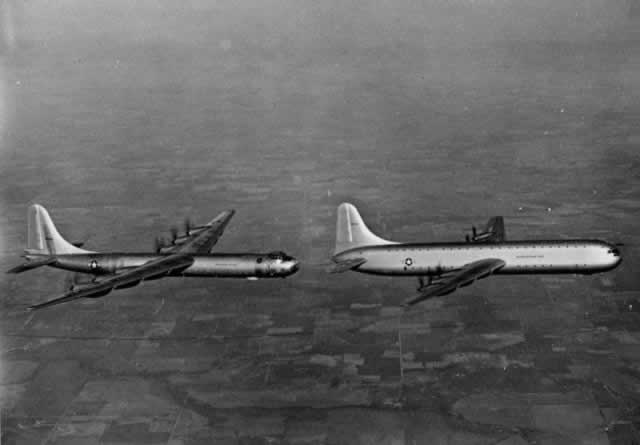 |
The Nuclear-Powered B-36
The NB-36H was a nuclear-powered version of the B-36. Originally a B-36H, S/N 51-5712, it completed 47 test flights and 215 hours of flight time between 1955 and 1957 over New Mexico and Texas.
The aircraft had been severely damaged in a tornado at Carswell AFB in Fort Worth in 1952. Rather than trying to repair the heavily-damaged nose section, the plane was kept by Convair and reassigned to the nuclear test program. In 1957, at the end of its testing, the NB-36H was decommissioned and scrapped at Carswell.
Convair NB-36H |
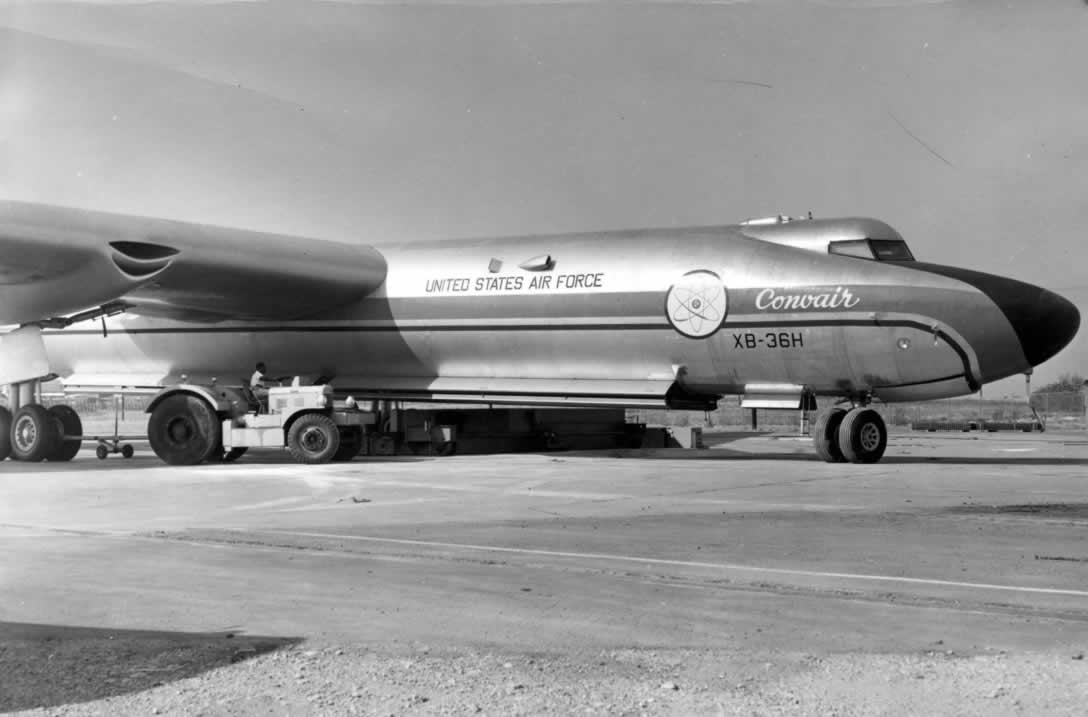 |
End of Service and Scrapping of the B-36
The final Peacemaker, B-36J-III-10-CF, S/N 52-2827A, came off the assembly line on August 14, 1954, and was assigned to the 92nd Bomb Wing at Fairchild AFB in Spokane, Washington.
When production ceased, a total of 382 B-36 Peacemakers had been built, plus one XC-99 and two YB-60, for a total of 385 aircraft of all variants.
Four B-36 were selected for preservation, along with the cargo version of the B-36, the XC-99.
By 1953, the Air Force made the decision to procure the Boeing B-52 Stratofortress instead of the Convair YB-60 as its next long-range heavy bomber. On June 29, 1955, the first B-52 was delivered to SAC by Boeing.
In February of 1956, the first B-36 aircraft arrived at Davis-Monthan Air Force Base in Arizona for storage and eventual dismantling. Once known as the Military Aircraft Storage and Disposition Center (MASDC), the facility today is the 309th Aerospace Maintenance and Regeneration Group (AMARG), the sole aircraft boneyard and parts reclamation facility for all excess military and government aircraft.
Reclamation and scrapping at Davis-Montan were contracted to the Mar-Pak Corporation, Painesville, Ohio. Mar-Pak had reclaimed 161 B-36s by December of 1957 and processed the last B-36 in April of 1959. By then the Air Force had a fleet of about 500 Stratofortresses.
By late 1958 only 22 B-36s were left on active duty. On February 12, 1959, the last operational flight of the B-36 took place, as 52-2827 flew from Biggs AFB to Fort Worth's Amon Carter Field. It remained on display for several years in that city, until its move in 2005 to the Pima Air and Space Museum in Tucson where it is currently located.
![]() Davis-Monthan AFB's AMARG facility
Davis-Monthan AFB's AMARG facility
Ground level view at Davis-Monthan AFB of B-36 Peacemakers in storage in 1958 RB-36H Serial Number 51-13723 of the 72nd Bombardment (Heavy) Wing is seen in the foreground |
 |
Aerial view of Convair B-36 Peacemakers, with engines removed, at Davis-Monthan Air Force Base awaiting final reclamation.
The last Peacemaker was scrapped on July 25, 1961 |
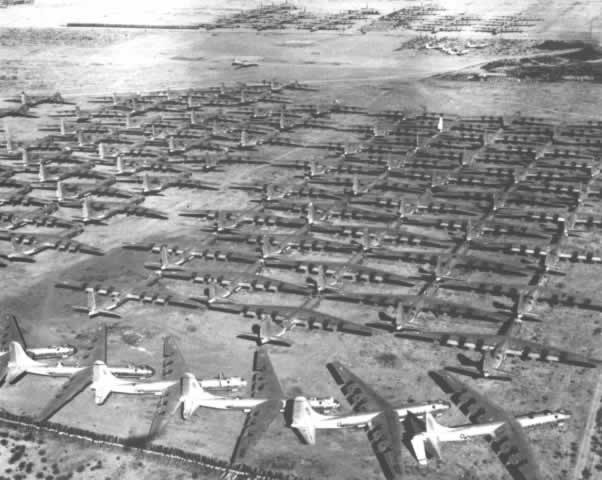 |
Row of propellers removed from Convair B-36 Peacemakers during the scrapping process at Davis-Monthan Air Force Base |
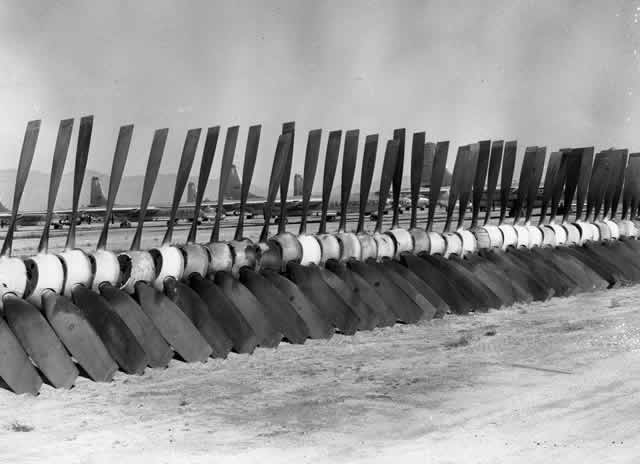 |
Aerial view of nine B-36 Peacemakers being scrapped at Davis-Monthan AFB, Tucson, Arizona |
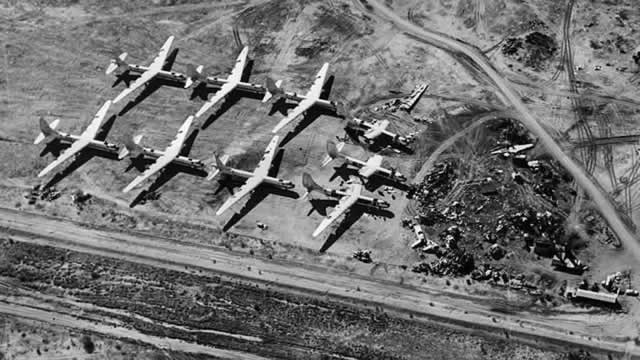 |
Advertisement by the Mar-Pak Corporation for the sale of B-36 surplus parts at its Davis-Monthan facility in Tucson |
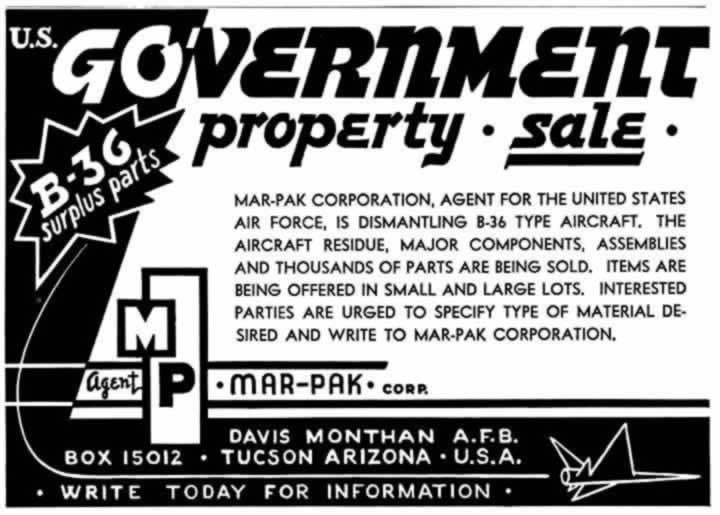 |
 |
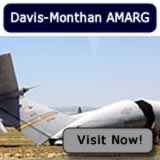 |
List of B-36 Survivors
The B-36 survivors are listed below ... click the links for additional information and photographs of the airplane at each facility. The Airplanes Online staff has had the honor of viewing, touching and photographing all four survivors.
Facility |
Location |
Model |
Serial No. |
| National Museum of the U.S. Air Force | Wright-Patterson Air Force Base Dayton, Ohio |
B-36J-1-CF | 52-2220 |
| Pima Air and Space Museum | Adjacent to Davis-Monthan Air Force Base Tucson, Arizona |
B-36J-10-CF | 52-2827 |
| Strategic Air Command and Aerospace Museum | Ashland, Nebraska | B-36J-1-CF | 52-2217 |
| Castle Air Museum | Atwater, California | RB-36H-30-CF | 51-13730 |
NOTE: Parts of a fifth B-36, S/N 42-13571, on display at the Air Force Museum in Dayton until December of 1957, are located in Newbury, Ohio, in the Walter Soplata Aviation Collection. It was originally a YB-36, the first Peacemaker with the domed cockpit, and later converted to a RB-36E.
Will the B-36 Ever Fly Again?
There is lots of interest among aviation historians and Air Force enthusiasts in having the B-36 fly again.
After all, there have been successful projects to restore two B-29 Superfortresses to flight status, i.e., FiFi and Doc.
Other vintage aircraft have survivors in flight, such as the B-17, B-24, B-25, P-51, DC-3, F-100 and others. Why not have a B-36 in flying status?
![]() About the restoration of a B-36 to flying status
About the restoration of a B-36 to flying status
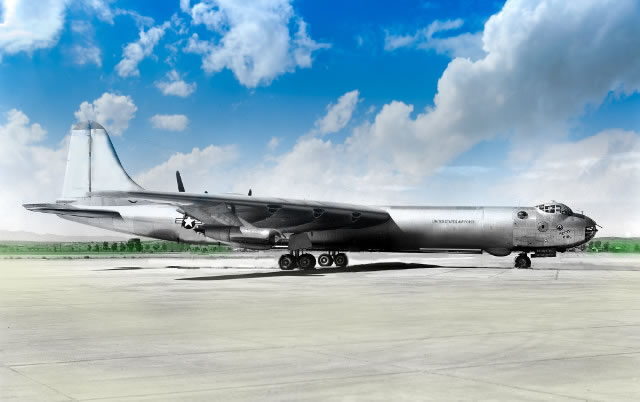 |
The B-36's Role in the "Strategic Air Command" Movie
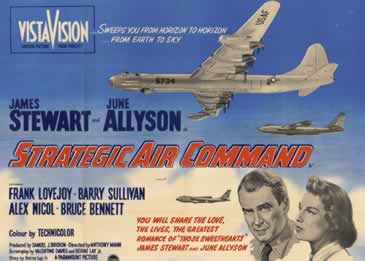 Strategic Air Command movie poster showing B-36H Serial Number 51-5734 used in the memorable startup and takeoff sequences in the movie. |
Most B-36 Peacemaker fans know the classic film Strategic Air Command, the 1955 Paramount Pictures movie starring James Stewart as Lt. Colonel Robert R. "Dutch" Holland and June Allyson as his wife Sally.
Also starring in the motion picture were Frank Lovejoy and Harry Morgan.
The movie premiered in New York on April 20, 1955, and in Los Angeles on April 28, 1955.
The film includes some of the most dramatic aerial photography ever filmed, for which it was awarded a special citation by the American National Board of Review.
One of the memorable scenes in the movie is the startup and takeoff sequence of the B-36H S/N 51-5734 airplane (see video below).
It is also the only motion picture to highlight the B-36, and was filmed with the cooperation of the Air Force at Carswell AFB, MacDill AFB in Tampa, and Lowry AFB in Colorado.
 About the Strategic Air Command movie
About the Strategic Air Command movie
B-36 Photographs by the Airplanes Online Staff
Cockpit view of the B-36J Peacemaker at the National Museum of the U.S. Air Force more photos |
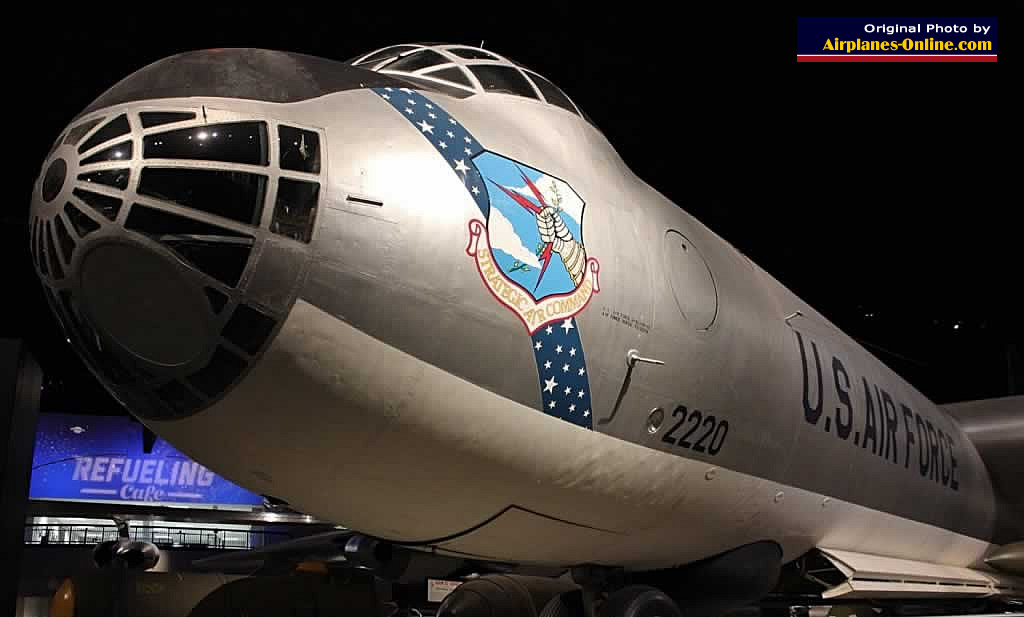 |
Convair B-36J Peacemaker S/N 52-2827 at the Pima Air & Space Museum more photos |
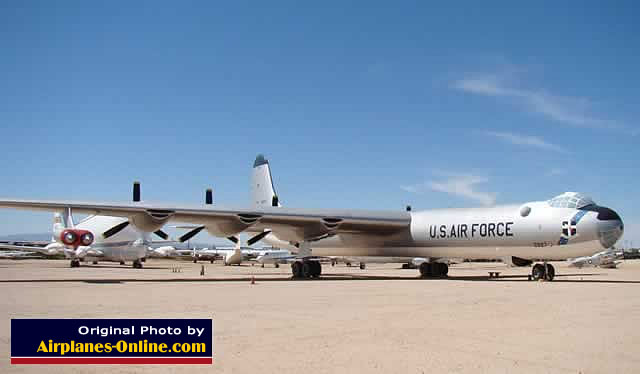 |
Nose view of the B-36J Peacemaker "City of Ft. Worth" 2827 more photos |
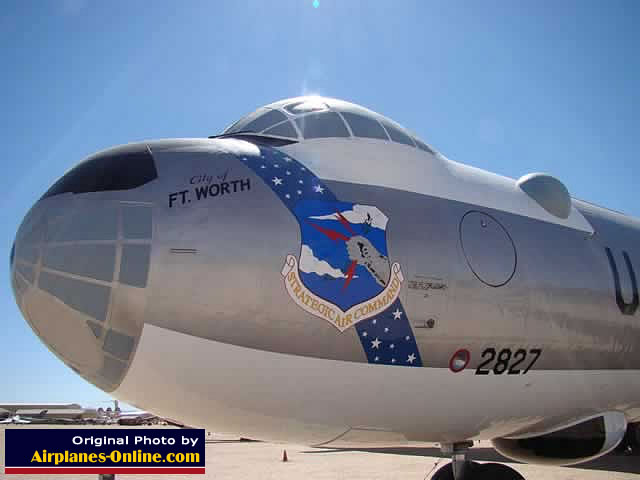 |
RB-36H S/N 51-13730 at the Castle Air Museum, Atwater, California more photos |
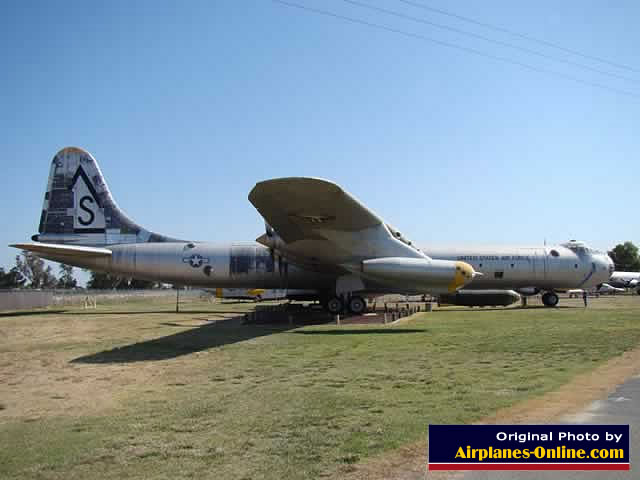 |
RB-36H Peacemaker on display at the Castle Air Museum in California more photos |
 |
Convair B-36J Peacemaker S/N 52-2217 at the Strategic Air & Space Museum in Nebraska view more photos of this B-36 |
|
B-36H Peacemaker Manuals
Highlights of B-36H Flight Manuals are included on this website, courtesy of Robert Rummel, whose father was a B-36 pilot during the 1950s. click to view the manuals
More B-36 About the B-36: Design, Production, Deployment & Scrapping B-36 - National Museum of the U.S. Force B-36 - Pima Air & Space Museum B-36 - Strategic Air Command & Aerospace Museum |


